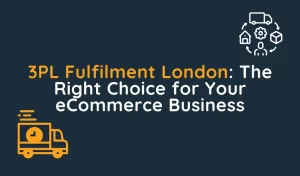In the world of eCommerce, few opportunities are as appealing as Seller Fulfilled Prime (SFP) on Amazon. The promise of the Prime badge, which offers increased visibility, faster shipping times, and greater customer trust, can transform a business’s ability to grow and thrive. But before you dive into SFP, it’s essential to weigh the costs and benefits to determine if it’s the right fulfillment model for your business.
In this blog post, we’ll take a deep dive into the investment required for Seller Fulfilled Prime, comparing it with the potential returns. Whether you’re a seasoned seller or new to the world of Amazon FBA, understanding the financials behind Seller Fulfilled Prime fulfilment will help
What Is Seller Fulfilled Prime?
Before jumping into the number, What is Seller Fulfilled Prime? SFP allows sellers to fulfill their own orders directly from their warehouse but still offer the Prime badge to their customers. This is in contrast to Fulfilment by Amazon (FBA), where Amazon stores and ships your inventory.
To be eligible for Seller Fulfiled Prime, your business needs to meet Amazon’s high standards, including guaranteed 2-day shipping, a certain level of customer service, and performance metrics that maintain a positive experience for Amazon shoppers. This gives your products the advantage of being marked as Prime-eligible without Amazon handling the fulfilment.
FBA vs SFP Cost Comparison
Understanding the costs of Seller Fulfilled Prime (SFP) can be more insightful when compared with Fulfillment by Amazon (FBA). Here’s how the two models stack up in terms of cost and logistics:
1.Fulfillment Costs
– FBA: Amazon takes care of storage, packing, and shipping. While you pay storage fees, order fulfilment, and other related charges (e.g., removal fees, return processing fees), these are generally predictable and scale with sales volume. While FBA is convenient, especially for scaling, the fees can sometimes outweigh the benefits—especially during peak seasons when storage rates surge.
Check out our blog ‘Tired of FBA Fees? Seller Fulfilled Prime Might Be The Answer.‘
– SFP: You cover your own shipping costs, including free 2-day delivery, which can quickly add up, especially for large or bulky items. Additionally, you bear the cost of warehousing, labour, and returns management, making it more complex to budget for.
2.Control Over Inventory
– FBA: Amazon controls the inventory. You send it to Amazon’s fulfillment centers, and they handle the rest. You’re bound by Amazon’s restrictions and performance guidelines.
– SFP: You maintain control over your inventory, which can be advantageous if you have special storage needs or want more flexibility in managing stock.
3.Customer Service and Returns
– FBA: Amazon handles customer service and returns, which can relieve a significant burden on your business. However, you pay for the convenience.
-SFP: You are responsible for customer service and returns, which requires additional resources, such as hiring staff or outsourcing.
4.Prime Badge
-FBA: Automatically gets your products the Prime badge, which is a significant benefit for visibility and conversions.
– SFP: You still get the Prime badge, but you must meet strict performance standards, including 2-day shipping and customer service expectations.
Which is more cost-effective?
For many businesses, FBA offers a more predictable and hands-off approach, particularly if you’re a smaller seller or don’t have the infrastructure to handle logistics. However, Seller Fulfilled Prime can be more beneficial for businesses that need to retain control over their inventory and want to manage shipping and customer service themselves.
Cost-Benefit Comparison: Is Seller Fulfilled Prime Worth It?
To determine if Seller Fulfilled Prime is worth the investment for your business, you need to consider the potential return on investment (ROI). Here’s how we break it down:
– Initial Costs: Shipping, technology, customer service, and potential third-party logistics costs can total a substantial amount.
– Ongoing Costs: These costs will continue to evolve, particularly as your business grows and more orders are placed. You’ll also need to keep an eye on performance metrics to maintain SFP eligibility.
– Benefits: The increase in visibility, better customer experience, and improved sales conversion rates are key benefits that justify the upfront costs. By offering the Prime badge, your products gain an advantage in a competitive market, potentially resulting in higher sales volume.
Ultimately, Seller Fulfilled Prime can provide excellent returns for businesses that are prepared to handle the logistics and customer service demands. However, it’s not a one-size-fits-all solution. If your business is small and doesn’t have the infrastructure to handle quick shipping, returns, and customer service, you may want to consider Fulfillment by Amazon (FBA) or another solution.
Conclusion
Is Seller Fulfilled Prime worth it for your business? The answer largely depends on your unique circumstances. If you have the resources to manage the logistics, customer service, and shipping demands, Seller Fulfilled Prime can be a highly profitable way to grow your eCommerce business. The benefits of increased visibility, customer trust, and more control over fulfillment operations are clear, but they come with their own set of costs.
For businesses that are ready to scale and provide a premium service to customers, the investment in Seller Fulfilled Prime can pay off significantly. However, make sure to assess your business’s needs and capabilities carefully before making the leap.
If you’re still unsure whether Seller Fulfilled Prime is the right fit, we recommend consulting with a 3PL provider or logistics expert who can guide you through the process and help you determine the best fulfillment strategy for your business.



